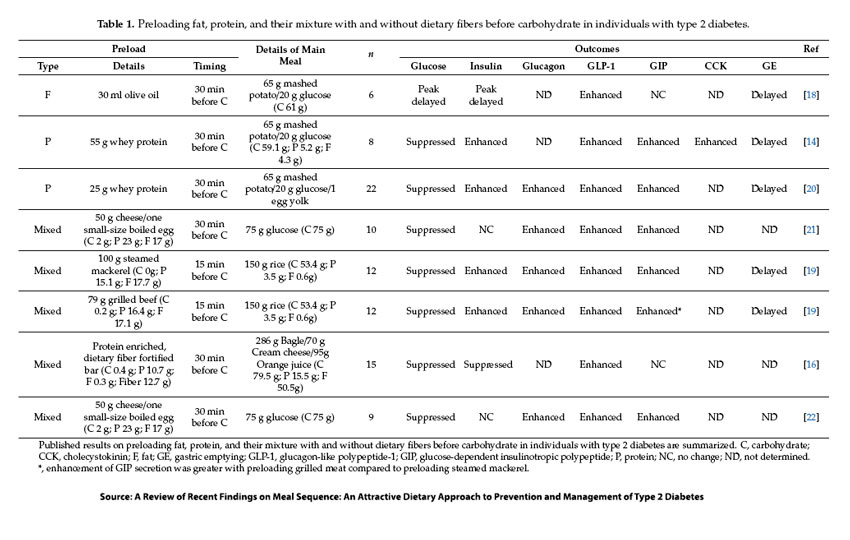For those not fully immersed in social media, our digital version of Popular Mechanics, Scientific American, Reader’s Digest, and the Enquirer, sequential meals or eating refers to a specific sequence in which you eat your food. Since we digest food at different rates, some argue that we should eat all of one type of food before going on to the next. Millions of years of evolution have eliminated the need for “mono-eating.”
On the more scientific end of the spectrum lies the idea that by eating the proteins on our plate, meat or fish, before those tasty carbohydrates, vegetables, and slices of bread, we may tinker with our digestion in more useful ways.
The Good News
Semaglutide and sequential meals both share the same underlying physiological explanation. By now, we are all aware of the wonder hormone, GLP-1, Glucagon-like peptide – 1. GLP-1 is released in the gut in response to the food reaching the stomach and intestines. It
- Increases insulin secretion
- Suppresses glucagon secretion
- Delays gastric emptying
- Suppresses appetite
Those last two actions are most important to the weight loss crowd because they both promote a feeling of satiety, leading to less eating, fewer calories, and weight loss.
Semaglutides are GLP-1 receptor agonists, meaning they act upon our receptors to mimic the actions of GLP-1. Novo Nordisk points out their version is "94% similar to natural occurring GLP-1.” [1] But GLP-1 increases in the presence of digesting protein and fats, so beginning your meal with these foods and waiting a bit will result in the earlier release of GLP-1; you will feel full sooner, eat less of those carbohydrates, and lose weight.
“It is not nice to fool with Mother Nature” [2]
Most of the science underlying the concept of sequential eating can be found in two articles listed under Sources. The first is a meta-analysis of seven studies, and the second a clinical trial of sequential eating; both are looking at the effect of sequential eating on diabetes. Like semaglutides, the initial scientific interest was in lowering the “spike” in blood glucose associated with meals to improve the day-to-day management of glucose in individuals with Type II diabetes. That is why you see Novo Nordisk, whose focus has been diabetes, at the forefront of developing these drugs. The weight loss was a fortuitous side effect or, as our tech brethren would say, a “feature, not a bug.”
The meta-analysis demonstrated that a variety of fats or proteins eaten before carbohydrates resulted in “suppressed” levels of glucose, enhanced release of GLP-1, and delayed gastric emptying. Here is the data in one table.
 There is only one fly in the ointment; in all but one study, you had to wait 30 minutes between the time you ingested the proteins and fats and began to eat the carbohydrates – inconvenience aside, the rice and mashed potatoes will be cold.
There is only one fly in the ointment; in all but one study, you had to wait 30 minutes between the time you ingested the proteins and fats and began to eat the carbohydrates – inconvenience aside, the rice and mashed potatoes will be cold.
The meta-analysis also found that “preloading” dietary fiber [3] would improve postprandial blood glucose but didn’t impact GLP-1. Remember, these studies were designed to improve blood sugar, not result in weight loss, and were conducted in individuals diagnosed with diabetes or “pre-diabetes.” But to be optimistic, the authors did suggest that a combination of preloaded protein or fat and dietary fiber may have additive effects on glucose and body weight.
The clinical trial involved three groups of approximately 10 to 15 individuals, all characterized as having “pre-diabetes,” each given dietary instructions to balance their caloric intake with expenditures. One group was also asked to eat a specific meal sequence, proteins first, and then wait a timed five minutes before eating carbohydrates. Another group was asked to eat a more balanced diet, the type described by the USDA’s MyPlate.
Let’s begin with the good news. The researchers noted that it was far easier to sequence your eating than to adhere to a nutritionally balanced diet. And now, the less good news. Over six months, the control group lost 0.1kg, those following a meal sequence lost 0.5kg, roughly a pound, and those following a balanced diet lost 0.7 kg. These weight losses pale in comparison to the results using the semaglutides. And there is more bad news for the meat eaters among us. The choice of proteins can make a difference. Fish is higher in polyunsaturated fatty acids, better for cardiovascular disease, and does not impact another hormone, GIP, that preloading with meat does. GIP, or glucose-dependent insulinotropic peptide, promotes “excess” calories to be stored in adipose tissue. Meat increases GIP, allowing more of those calories to be stored for a “rainy day.” – in translation, meat proteins may reduce the beneficial weight loss from sequential eating because they add adipose tissue.
If you are looking for the magic bullet to lose weight quickly, sequential eating or meals, while grounded in our physiologic responses, has yet to be proven to have a significant effect. Social media continues to be “junk information,” easily digested and full of absent or misleading facts strung together to capture your attention.
[1] For those searching for a natural product, you must ask yourself what 94% similar actually means. Similar is already a term we use when something is not the same, so does that 94% number promote understanding or lend a bit of a misplaced scientific “halo” to a medication that is not the same as GLP-1?
[2] Ironically, the quote comes from a '70s commercial selling margarine.
[3] Dietary fiber, the undigested, unabsorbed part of our diet, delays gastric emptying and gives a sense of fullness as the fibers swell and increase the thickness (viscosity) of our stomach contents. The slowing of gastric emptying results in less glucose being presented for absorption by the intestine at any one moment, reducing the blood glucose spike.
Sources: Dietary instructions focusing on meal-sequence and nutritional balance for pre-diabetes subjects: An exploratory, cluster-randomized, prospective, open-label, clinical trial Journal of Diabetes Complications DOI: 10.1016/j.jdiacomp.2019.107450
A Review of Recent Findings on Meal Sequence: An Attractive Dietary Approach to Prevention and Management of Type 2 Diabetes Nutrition DOI: 10.3390/nu12092502




